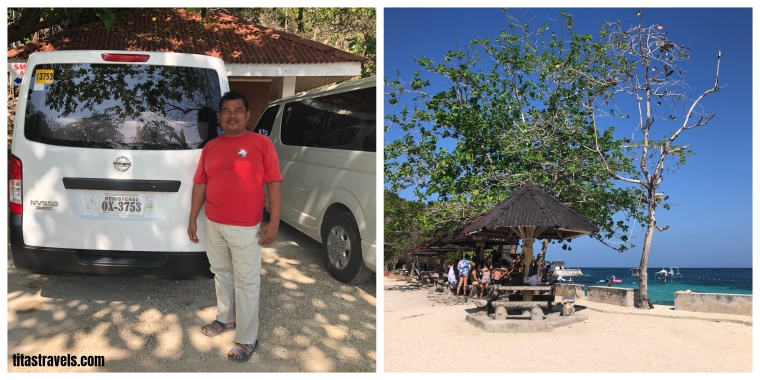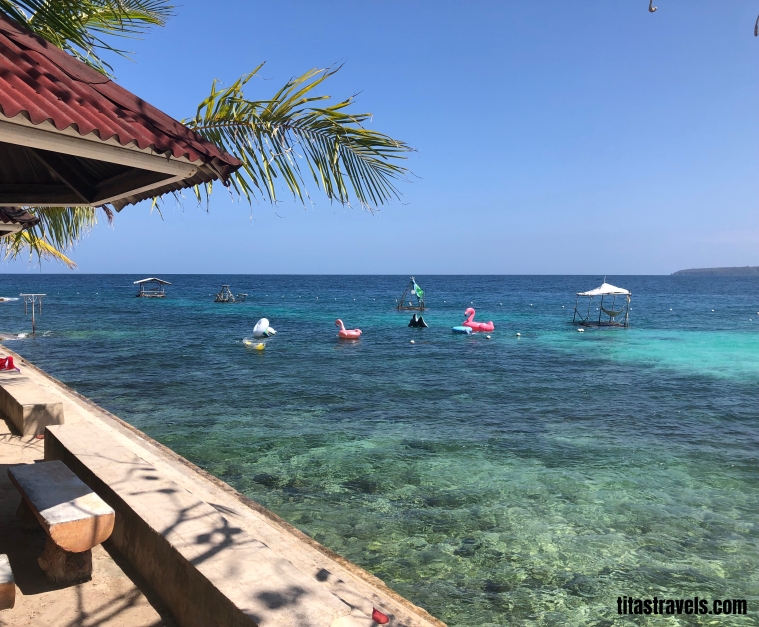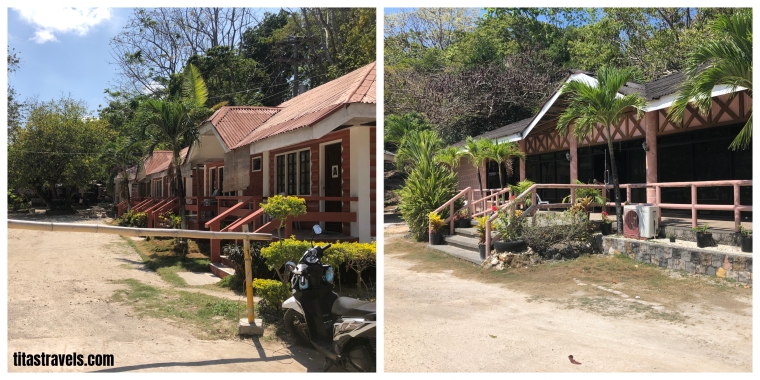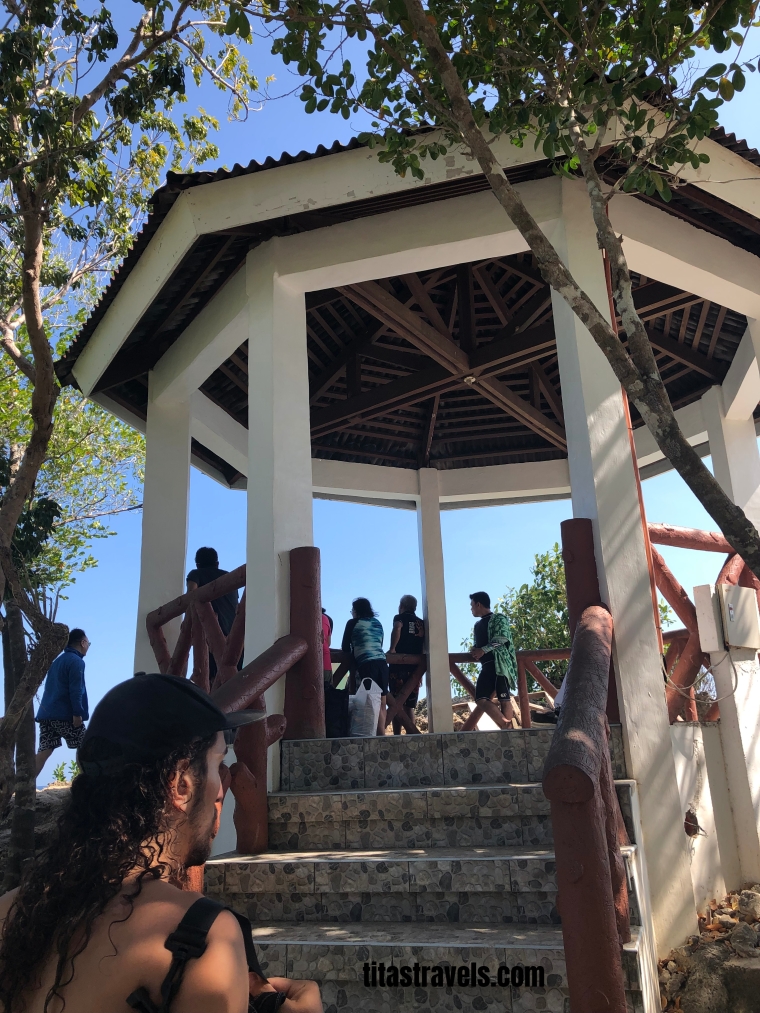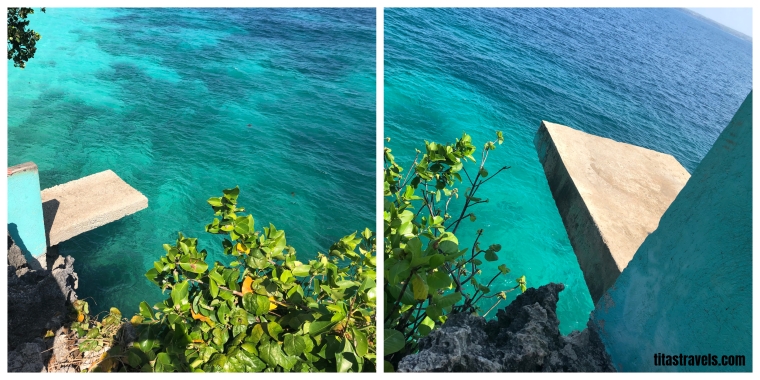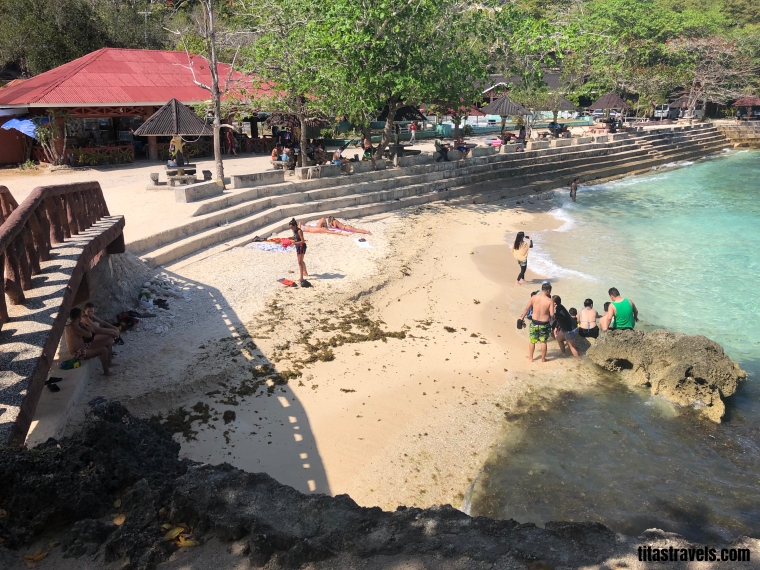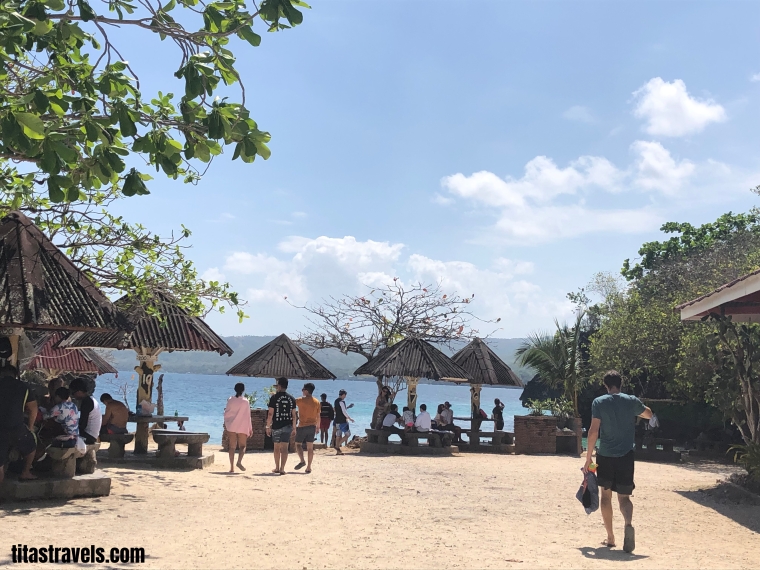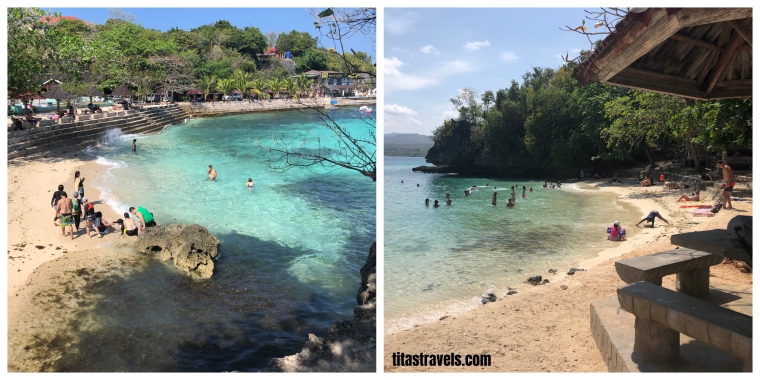Cambugahay Falls is a famous tourist destination in the island province1 of Siquijor2, in the Central Visayas3 Region (Region VII)4 of the Philippines. It is a three-tiered waterfall that flows naturally into a lake. Said lake, I was told, apparently has healing powers.
This is the fifth stop (out of six) of our one-day Siquijor Coastal Tour. At the port of Siquijor2, we rented an air-conditioned van owned by Yane’s Adventures Van Services5. We had a very friendly, cheerful and accommodating driver, Jimmy Bueno.
And now, for my experience in this destination:
Cambugahay Falls can be accessed from the Siquijor Circumferential Road, in the town of Lazi6. It would be best to visit this place during weekdays and to go early to avoid the large number of people.
The parking area is on the opposite side of the street. The parking fee is PHP30 per vehicle.
Just cross the street from the parking area and you cannot miss the sign announcing Cambugahay Falls.
 Entrance, Cambugahay Falls – I hope the local tourism officials can improve its appearance and the local police can monitor groups to prevent the vandalism of signages
Entrance, Cambugahay Falls – I hope the local tourism officials can improve its appearance and the local police can monitor groups to prevent the vandalism of signages
And guess what? There is no entrance fee to use this facility! You will then be offered the services of a guide or lifeguard, and it is up to you how much to give him as service fee. We opted to have one guide since we had a 7-year-old child with us. If you and your companions can swim, then you may not need avail of this service.
Thereafter, simply go down around 140 cemented steps made with large smooth stones. The downward trek is approximately 10 minutes, depending, dearest Senior Citizens, on the pacing of your steps. Be careful when you go down since there are no handrails. Hold on to a younger companion while going down the steps, just to be sure, dearest Seniors! I strongly recommend that handrails be installed along the steps so that children, elders, and other persons who have difficulty going up and down these uneven steps can safely do so.
I strongly recommend that handrails be installed along the steps so that children, elders, and other persons who have difficulty going up and down these uneven steps can safely do so.
Your brief journey downwards will be rewarded by a captivating view of the third (bottom) level of the waterfalls, the biggest and deepest of all three levels. The third tier of Cambugahay Falls, with three diving spots (left of picture, middle with green slope, and right, with man seated)
The third tier of Cambugahay Falls, with three diving spots (left of picture, middle with green slope, and right, with man seated)
These three swinging areas offer different heights to fall from, and you start to wonder, after seeing so many tourists doing a Tarzan-like jump, if you could also be brave enough to do so. If I were younger, I guess I would have jumped too!
This is where you will be amazed with the daring jumps of local and foreign tourists swinging from a long rope in three different parts of the falls.
 You just need to cross this narrow wooden bridgelike structure over the shallow, flowing water to get to the area where you can stay and later, decide to swim, Tarzan-dive, and/or proceed to the two other levels of this falls.
You just need to cross this narrow wooden bridgelike structure over the shallow, flowing water to get to the area where you can stay and later, decide to swim, Tarzan-dive, and/or proceed to the two other levels of this falls.
Then, live your best life at Cambugahay Falls, swing, swing some more, let go, and prepare for your splash!
Most tourists just stay on this level of the falls. Some younger tourists repeatedly do the jump challenge, using different techniques of jumping. Some simply swim and enjoy the cool water.
So, adventurous, younger, and more fit Seniors, why not take the Tarzan-Swing-Dive Challenge? My two younger male companions took the challenge, used different styles of jumps from the rope to the water, and made wonderful splashes on the cool, refreshing waters. I was told that if you pay PHP20, you can have unlimited jumps. Should you prefer not to jump, then, enjoy the view, swim, breathe in the fresh air, and take lots of pictures, just like what I did!
Of course, your best option, dearest Seniors, is to swim and enjoy the bluish, and oh so cool, spring water. For non-swimmers, you can rent a life vest for PHP50. We rented a life vest for the 7-year-old, and for the hesitant non-swimmer in our group. Bottomline: do not miss the chance to try the refreshing water.
There are makeshift bamboo tables, free of charge, where you can leave your belongings while you swim. It would be best to designate someone from your group to watch over your things.
 Notice the bamboo tablelike structures to the right of the life vest rental where people are seated? Those are the makeshift tables I mentioned which you could use to place your things while you swim or Tarzan-dive. Remember to place sunblock 30 minutes before sun exposure.
Notice the bamboo tablelike structures to the right of the life vest rental where people are seated? Those are the makeshift tables I mentioned which you could use to place your things while you swim or Tarzan-dive. Remember to place sunblock 30 minutes before sun exposure.
I noticed that there are no food stalls but saw a group of tourists being served food and drinks, delivered to their bamboo table. So, inquire about such services, if needed. However, I suggest you just bring your own snacks, since you will probably stay here for only 1-2 hours anyway, and then to find a decent restaurant in between stops.
Seniors, if you feel energetic and adventurous, why not proceed to the two higher tiers? These levels are more serene because fewer tourists go there. You can also swim in these two levels and I was told that the water is shallower in these two basins. It just so happened that I was not feeling well that day so I did not venture to see these two higher levels. If you did during your Siquijor tour, please tell me about it, ok?
There is no washroom, restroom, nor changing room in this place so some of us changed quickly behind a large bath towel (held by companions), while some opted to just exit the area without changing.
We only stayed here for about an hour, since it was also starting to get crowded and we had to proceed to our last, and final, destination – a beach called Salagdoong Beach7 – where we intended, anyway, to swim again.
A word of caution, dearest Seniors: leaving Cambugahay Falls entails that you climb all the way up to the entrance, about 10-15 minutes, on the same steps you used going down to the falls. Remember, there are no handrails, so pace yourself, or better still, hold on to a younger person. Take your time; you just swam for an hour so just rest after several steps. Accidents occur when you are in a hurry. Just tell you younger companions to be a bit patient and I am sure they will wait for you at the top.
We paid for our Siquijor Coastal Tour and all comments are based on my personal experience in this province1.
You can read a related post about my Siquijor tour – SERENE AND SPONTANEOUS SALAGDOONG BEACH, SIQUIJOR, GET BEWITCHED AT HAPITANAN, SIQUIJOR, Now You Know – SIQUIJOR: ITS LEGEND, HISTORY, TRADITIONS, AND BELIEFS and ENCHANTING 400-YEAR-OLD BALETE TREE AND FISH SPA, SIQUIJOR
Did you find this post informative? I would like to hear from you regarding your visit to captivating Cambugahay Falls. Did you take the Tarzan-Swing-Dive Challenge? Simply scroll and click “Leave a comment”.
See other interesting places through other posts in this category and other categories of SCapades, Pinoy Delights, and Smart Travelers – Foreign Travelers Ask, Now You Know, and Say, Say, Say. Happy reading, and I hope that you will appreciate what I shared and some of the featured destinations will be part of your future travel plans!
Remember to share this post with your friends, follow me by clicking on the bottom right corner of your device, and do not forget to like this post. Thank you.
– – – – – – – – – – – – – – – – – – – – – – – – – –
The following terms are defined for interested readers, especially non-Filipinos, those with “Senior-Moments”, and those too busy or lazy to Google such terms:
1A province is the primary administrative and political division in the Philippines. It is the second-level administrative sub-division of a region8. There are 81 provinces (called “lalawigan”) in the Philippines. Each province is governed by an elected legislature called the Sangguniang Panlalawigan and by an elected governor. In the Philippines, a province is divided into cities9 and municipalities10 (or towns), which in turn, are divided into barangays11, formerly called barrios. The information was obtained from Wikipedia page “Provinces of the Philippines.”12 See a related post: Foreign Seniors Ask: WHAT ARE PROVINCES IN THE PHILIPPINES?
2Siquijor is an island province1 of the Philippines located in the Central Visayas3 Region (Region VII)4. Its capital is the municipality10 which is also called Siquijor. This coralline island is predominantly hilly, and in many places the hills reach the sea, producing steep cliffs. Geographically, Cebu is to the north, Negros to the west, Bohol to the northeast, and to the south, across the Bohol Sea, is Mindanao. It has a long-time reputation as a place of magic, sorcery, and mystical traditions. It is also well known for its festivals that focus on healing rituals. The information was obtained from the Wikipedia page “Siquijor”.13
3Visayas is one of the 3 major geographical divisions of the Philippines. It covers 3 administrative regions: Central Visayas4, Eastern Visayas and Western Visayas. It consists of 6 major islands (Bohol, Cebu, Leyte, Negros, Panay and Samar), mostly surrounded by the Visayan Sea, and is composed of 16 provinces1, according to Wikipedia page “Visayas”.14 Visayas is located at the middle part of the country; the 2 other geographical divisions of the Philippines are Luzon (in the northern part) and Mindanao (in the southern part).
4Central Visayas (Region VII) of the Philippines is a Philippine region8 located in the island group of Visayas3, with Cebu City as its regional center. It has 7 local government units15 (LGUs): Bohol, Cebu, Cebu City, Lapu-Lapu, Mandaue, Negros Oriental, and Siquijor2. The information was obtained from Wikipedia page “Regions of the Philippines.”16
5Yane’s Adventures Van Services information – Address: Pangi, Siquijor, Siquijor; Contact numbers: 09052133123, 09069732330 and 09183124461, look for Jade Jumawan Pestillos, and request for our very accommodating and cheerful driver, Jimmy Bueno.
6Lazi, formerly called Tigbawan, is a coastal municipality10 in the island province1 of Siquijor2, with 18 barangays11. It is located in the southeastern side of the island, between the towns of San Juan in the west and Maria from the east. It is known for its Roman Catholic church called San Isidro Labrador Parish Church (a National Historical Landmark17, a National Cultural Treasure18, and included in the tentative list for UNESCO World Heritage Sites19 under the Baroque20 Churches of the Philippines-Extension), the Convent in front of it (one of the largest convents built during the Spanish colonial era21), the 400-year-old enchanting balete tree with fish spa, and Cambugahay Falls (see above). The information was obtained from the Wikipedia page “Lazi, Siquijor”22 and “Siquijor”13. Visit this site for more information: http://www.phtourguide.com/municipality-of-lazi-in-siquijor/
7Salagdoong Beach is a popular tourist destination in the town of Maria, on the southeastern side of the island province1 of Siquijor2, in the Central Visayas3 Region (Region VII)4 of the Philippines. This beach is known for swimming and cliff diving. It has crystal clear waters and white sand shores.
8A region is the first-order administrative division in the Philippines. There are 17 regions in the Philippines, based on geographical, cultural and ethnological characteristics. It is further subdivided into provinces1, composed of cities9 and municipalities10 (or towns), which in turn, are divided into barangays11. The regions were initially identified in 1972, through Presidential Decree No. 1 of President Ferdinand Marcos. Since then, other regions have been created and some provinces have been “transferred” to another region. The information was obtained from Wikipedia page “Regions of the Philippines.”16 See a related post: Foreign Seniors Ask: WHAT ARE THE REGIONS OF THE PHILIPPINES?
9A city is the local government unit15 in the Philippines headed by a mayor elected by popular vote. A vice-mayor serves as the presiding officer of the city’s legislative body – the Sangguniang Panlungsod (city council). The information was obtained from Wikipedia page “Cities of the Philippines.”23 See a related post: Foreign Seniors Ask: HOW MANY CITIES ARE THERE IN THE PHILIPPINES?
10A municipality is a small, single urban administrative division, or local government unit (LGU)15, in the Philippines which has corporate status and powers of self-government or jurisdiction as granted by law. It is a unit under a province1, subdivided into barangays11, and is called town, or bayan. In the Philippines, a municipality is headed by a mayor, a vice-mayor and members of the Sangguniang Bayan (legislative branch). It can enact local policies and laws, enforce them, and govern its jurisdictions. It can enter into contracts and other transactions through its elected and appointed officials, and can tax as well. It enforces all local and national laws. The information was obtained from Wikipedia page “Municipalities of the Philippines.”24
11A barangay in the Philippines is the smallest administrative division in the Philippines, headed by a barangay captain, aided by a Sangguniang Barangay (Barangay Council). It is the native Filipino term for a district or village. It was formerly called a barrio. In a metropolitan area, a barangay is an inner city neighborhood, a suburb, or a suburban neighborhood. The word barangay originated from the term “balangay”, a kind of boat used by a group of Austronesian people who migrated to the Philippines. A number of barangays grouped together is called a district. The information was obtained from Wikipedia page “Barangay.”25
12“Provinces of the Philippines,” accessed July 17, 2018, https://en.wikipedia.org/wiki/Provinces_of_the_Philippines
13“Siquijor,” accessed March 8, 2019,https://en.m.wikipedia.org/wiki/Siquijor
14“Visayas,” accessed January 29, 2019, https://en.wikipedia.org/wiki/Visayas
15A local government unit (LGU) in the Philippines is divided into 3 levels: provinces1 and independent cities26; component cities27 and municipalities10; and, barangays11, according to Wikipedia page “Local government in the Philippines”.28
16“Regions of the Philippines,” accessed January 29, 2019, https://en.wikipedia.org/wiki/Regions_of_the_Philippines
17A National Historical Landmark of the Philippines is a place or an object that is associated with an event, achievement, characteristics or modification that presents a turning point or stage in history. The information was obtained from the Wikipedia page “Category: National Historical Landmarks of the Philippines”.29
18A National Cultural Treasure (NCT) of the Philippines is a tangible (movable and immovable) or intangible heritage property declared by the National Commission for Culture and Arts30 and other cultural agencies such as the National Museum of the Philippines31, National Library of the Philippines32, and National Archives of the Philippines33. Such declarations are authorized under the National Cultural Heritage Act of 200934 and recognized within the Cultural Properties of the Philippines35 by the Philippine government. The title of NCT is the highest designation given to a “unique cultural property found locally, possessing outstanding historical, cultural, artistic and/or scientific value which is highly significant and important to the country and nation”.36 The information was obtained from the Wikipedia page “National Cultural Treasure”.37
19A UNESCO World Heritage Site (WHS) is a unique landmark, or geographically and historically identifiable place, which is selected by the United Nations Educational, Scientific and Cultural Organization (UNESCO) as having cultural, historical, scientific, physical or other form of significance, and is legally protected by international treaties. Sites are demarcated by UNESCO as protected zones. The list is maintained by the International World Heritage Program administered by the UNESCO World Heritage Committee, composed of 21 state parties which are elected by the General Assembly. Under certain conditions, listed sites can obtain funds from the World Heritage Fund. The information was obtained from the Wikipedia page “World Heritage Site”.38
20Baroque architecture began in Rome, Italy, in the late 16th century, which conveys grandeur and drama, most often used in palaces and churches. It includes curving forms, oval shapes, and a combination of concave and convex forms that make walls seem to undulate, or appear wavy, with a strong sense of motion. It groups things together like columns and decorative flourishes on building surfaces. Architectural elements are repeated across a surface. It uses distortion to make figures elongated, broken, or manipulated in some manner to make them stand out. Buildings have columns, sometimes topped with capitals and large volutes, scroll, or spiral forms. Sculptural wall elements will often project from the surface which is full of forms to increase the interplay of light and shadow across them. Inside, Baroque structures will often have ceilings painted in bright colors, made to fool one’s eye into believing one is looking at the sky. Buildings also have very rich surface treatments, including interiors with stucco39, various colored marbles, and gold gilt or thin sheets of gold applied to surfaces. Most Baroque churches have vaulted ceilings, supported by a series of interconnected arches.40
21The Spanish colonial era was the historical part of the Philippines from 1521, when European explorer Ferdinand Magellan arrived in the country, and ended in 1898, with the outbreak of the Philippine Revolution41. The information was obtained from the Wikipedia page “History of the Philippines from 1521 to 1898”.42
22“Lazi, Siquijor,” accessed March 8, 2019,https://en.m.wikipedia.org/wiki/Lazi,_Siquijor
23“Cities of the Philippines,” accessed January 29, 2019, https://en.wikipedia.org/wiki/Cities_of_the_Philippines
24“Municipalities of the Philippines,” accessed January 29, 2019, https://en.wikipedia.org/wiki/Municipalities_of_the_Philippines
25“Barangay,” accessed January 29, 2019, https://en.wikipedia.org/wiki/Barangay
26An independent city is a type of city9 in the Philippines which is administratively and legally not subject to a province1 so it does not share its tax revenues with any province. The national government and its agencies serve such a city through sub-offices of the region8 it belongs to. It is subdivided into 2: highly urbanized city43 or independent component city44. The information was obtained from Wikipedia page “Cities of the Philippines”23
27A component city is a type of city9 in the Philippines which does not meet the requirements of a highly urbanized city43. It is under the jurisdiction of a province1. If such a city is located along the boundaries of 2 or more provinces, it shall be considered part of the province of which it used to be a municipality10. The information was obtained from Wikipedia page “Cities of the Philippines”23
28“Local government in the Philippines,” accessed January 29, 2019, https://en.wikipedia.org/wiki/Local_government_in_the_Philippines
29“Category: National Historical Landmarks of the Philippines,” accessed October 16, 2018, https://en.wikipedia.org/wiki/Category:_National_Historical_Landmarks_of_the_Philippines
30The National Commission for Culture and Arts is the official government agency for culture in the Philippines, formed in 1987, with headquarters in General Luna Street, Intramuros, Manila. It is the overall policy making body, coordinating, and grants-giving agency for the preservation, development and promotion of Philippine arts and culture. Its parent department is the Office of the President of the Philippines and its sub-agencies are the: National Archives of the Philippines33, National Historical Commission of the Philippines45, National Library of the Philippines32, National Museum of the Philippines31, Commission on the Filipino Language, and the Cultural Center of the Philippines. The information was obtained from the Wikipedia page “National Commission for Culture and Arts”.46 Visit its website: www.ncca.gov.ph
31The National Museum of the Philippines is a government institution in the Philippines which serves as the educational, scientific and cultural institution in preserving the various permanent national collections featuring the ethnographic, anthropological, archaeological and visual artistry of the Philippines. It was formed on October 29, 1901, with headquarters in Padre Burgos Avenue, in Rizal Park, Ermita, Manila. Since 1998, it has been the regulatory and enforcement agency of the national government in restoring and safeguarding important cultural properties, sites and reservations throughout the Philippines. It is under the Department of Education and the National Commission for Culture and Arts30. The information was obtained from the Wikipedia page “National Museum of the Philippines”.47 Visit its website: www.nationalmuseum.gov.ph
32The National Library of the Philippines is the official national library of the Philippines, with over 1.6 million pieces in its collections. It is notably called the home of the original copies of the defining works of Jose Rizal (Noli Me Tangere, El Filibusterismo and Mi Ultimo Adios). It was established in 1901 and located in Rizal Park, at T. M. Kalaw Avenue, Ermita, Manila. The information was obtained from the Wikipedia page “National Library of the Philippines”.48 Visit its website: www.web.nlp.gov.ph
33The National Archives of the Philippines is an agency of the Philippines which is mandated to collect, store, preserve and make available, archival records of the government and other primary sources pertaining to the history and development of the country, as a result of the passage of Republic Act 9470 on May 21, 2007. It is the primary records management agency, tasked to formulate and implement the records schedule and vital records protection programs for the government. Its headquarters is in the National Library of the Philippines, in Rizal Park, at T. M. Kalaw Avenue, Ermita, Manila. The information was obtained from the Wikipedia page “National Archives of the Philippines”.49 Visit its website: www.nationalarchives.gov.ph
34The National Cultural Heritage Act is a law of the Republic of the Philippines which created the Philippine Registry of Cultural Property and took other steps to preserve historic buildings that are over 50 years old, signed into law on March 25, 2009, according to the Wikipedia page “National Cultural Heritage Act”.50
35The Cultural Properties of the Philippines refers to the cultural properties listed by the National Commission for Culture and Arts30, National Historical Commission of the Philippines45, and the National Museum of the Philippines31 through the Philippine Registry of Cultural Property (PRECUP), the official cultural property list of the country. The information was obtained from Wikipedia page “Cultural properties of the Philippines”.51
37“National Cultural Treasure,” accessed October 16, 2018, https://en.wikipedia.org/wiki/National_Cultural_Treasure
38“World Heritage Site,” accessed October 16, 2018, https://en.wikipedia.org/wiki/World_Heritage_Site
39Stucco refers to the cement-based and fine plaster used for coating wall surfaces or molding into architectural decorations. It hardens into a highly durable material that requires little maintenance and can be used to obtain different textures and finishes.52
40https://study.com/academy/lesson/italian-baroque-architecture-characteristics-examples.html
41The Philippine Revolution is the revolution that started on August 23, 1896, when the Spaniards discovered the Katipunan53, and ended on August 13, 1898. The Filipinos were victorious and this resulted in the expulsion of the Spanish colonial government, as well as: the signing of the Pact of Biak-na-Bato54 in 1897; the resumption of hostilities during the Spanish-American War55 in 1898; the establishment of the First Philippine Republic56; and, the outbreak of the Philippine-American War57 in 1899. The information was obtained from the Wikipedia page “Philippine Revolution”.58
42“History of the Philippines from 1521 to 1898,” accessed October 16, 2018, https://en.m.wikipedia.org/wiki/History_of_the_Philippines
43A highly urbanized city (HUC) is a type of city9 in the Philippines with a minimum population of 200,000 as certified by the Philippine Statistics Authority (PSA), and with the latest annual income of at least 50 million pesos, according to Wikipedia page “Cities of the Philippines”.23 There are currently 33 such cities in the Philippines (see link – I will place a link here).
44An independent component city (ICC) is a type of city9 in the Philippines which is autonomous from the province1 in which it is geographically located and has a charter that explicitly prohibits its residents to vote for provincial officials (unless allowed to do so). It does not meet the requirements of a highly urbanized city43. There are 5 such cities in the country: Cotabato, Dagupan, Naga, Ormoc, and Santiago. The information was obtained from Wikipedia page “Cities of the Philippines”23
45The National Historical Commission of the Philippines (NHCP) is a government agency of the Philippines which promotes Philippine history and cultural heritage through research, dissemination, conservation, sites management, and heraldry works, thereby inculcating awareness and appreciation of the noble deeds and ideals of our heroes and other illustrious Filipinos, instilling pride in the Filipino people, and rekindling the Filipino spirit through the lessons of history. The information was obtained from the Wikipedia page “National Historical Commission of the Philippines”.59
46 “National Commission for Culture and Arts,” accessed October 16, 2018,https://en.wikipedia.org/wiki/National_Commission_for_Culture_and_Arts
47“National Museum of the Philippines,” accessed October 16, 2018, https://en.wikipedia.org/wiki/National_Museum_of_the_Philippines
48“National Library of the Philippines,” accessed October 16, 2018, https://en.wikipedia.org/wiki/National_Library_of_the_Philippines
49“National Archives of the Philippines,” accessed October 16, 2018,https://en.wikipedia.org/wiki/National_Archives_of_the_Philippines
50“National Cultural Heritage Act,” accessed October 16, 2018, https://en.wikipedia.org/wiki/National_Cultural_Heritage_Act
51“Cultural properties of the Philippines,” accessed October 16, 2018,https://en.wikipedia.org/wiki/Cultural_properties_of_the_Philippines
52https://www.thebalancesmb.com/choose-right-stucco-mix-844655
53The Katipunan was the Philippine revolutionary secret society founded by anti-Spanish Filipinos in Manila in 1892 which aimed to gain independence from Spain through a revolution, according to the Wikipedia page “Katipunan”.60
54Pact of Biak-na-Bato was a truce between Spanish colonial Governor-General Fernando Primo de Rivera and the revolutionary leader Emilio Aguinaldo to end the Philippine Revolution34, signed on December 14, 1897, in the house of Pablo Tecson (a Philippine revolutionary captain who served as Brigadier General under General Gregorio del Pilar) in San Miguel, Bulacan. Aguinaldo and his fellow revolutionaries were given amnesty and monetary indemnity by the Spanish government, in return for which the revolutionary government would go on exile in Hong Kong. The information was obtained from Wikipedia page “Pact of Biak-na-Bato”.61
55The Spanish-American War was fought between Spain and the United States in 1898. Hostilities began in the aftermath of the internal explosion of USS Maine in Havana Harbor, in Cuba, leading to US intervention in the Cuban War of Independence. The Americans won and it resulted in the Treaty of Paris62, signed on December 10, 1898. Said treaty came into effect on April 11, 1899, when the documents of ratification were exchanged, with Spain relinquishing all claims of sovereignty over and title to Cuba, and ceded Puerto Rico, Guam and the Philippines to the US. The cession of the Philippines involved a compensation of $20 million from the US to Spain. The information was obtained from Wikipedia pages “Spanish-American War”63 and “Treaty of Paris of 1898”64.
56The First Philippine Republic, or the Malolos Republic, was a nascent revolutionary government in the Philippines, established after the Philippine Revolution41 against the Spanish Empire (1896-1897) and the Spanish-American War55, and was the first constitutional republic in Asia, with a comprehensive constitution duly approved by a partially elected congress. It was formally established with the proclamation of the Malolos Constitution on January 21, 1899, in Malolos, Bulacan, and endured until the capture of President Emilio Aguinaldo by the American forces on March 23, 1901, in Palanan, Isabela. The information was obtained from Wikipedia page “First Philippine Republic”.65
57The Philippine-American War, the Philippine War, the Philippine Insurrection, or the Tagalog Insurgency, was an armed conflict between the First Philippine Republic56 and the USA that lasted from February 4, 1899 to July 2, 1902. The conflict arose when the former objected to the terms of the Treaty of Paris62, under which the US took possession of the Philippines from Spain, ending the short Spanish-American War55. The information was obtained from Wikipedia page “Philippine-American War”.66
58“Philippine Revolution,” accessed October 16, 2018, https://en.wikipedia.org/wiki/Philippine_Revolution
59“National Historical Commission of the Philippines,” accessed October 16, 2018, https://en.wikipedia.org/wiki/National_Historical_Commission_of_the_Philippines
60“Katipunan,” accessed October 16, 2018,https://en.wikipedia.org/wiki/Katipunan
61“Pact of Biak-na-Bato,” accessed October 16, 2018, https://en.wikipedia.org/wiki/Pact_of_Biak-na-Bato
62The Treaty of Paris was an agreement, signed on December 10, 1898, that involved Spain relinquishing nearly all the remaining Spanish Empire, especially Cuba, and ceding Guam, Puerto Rico, and the Philippines to the US, thus ending the Spanish-American War55. It came into effect on April 11, 1899, when the documents of ratification were exchanged. The cessation of the Philippines involved a payment of US$20 million from the US to Spain. The information was obtained from the Wikipedia page “Treaty of Paris (1898)”.64
63“Spanish-American War,” accessed November 2, 2018, https://en.m.wikipedia.org/wiki/Spanish_American_War
64“Treaty of Paris,” accessed November 2, 2018, https://en.m.wikipedia.org/wiki/Treaty_of_Paris.
65“First Philippine Republic,” accessed October 16, 2018, https://en.wikipedia.org/wiki/First_Philippine_Republic
66“Philippine-Amercian War,” accessed November 2, 2018, https://en.m.wikipedia.org/wiki/Philippine-American_War



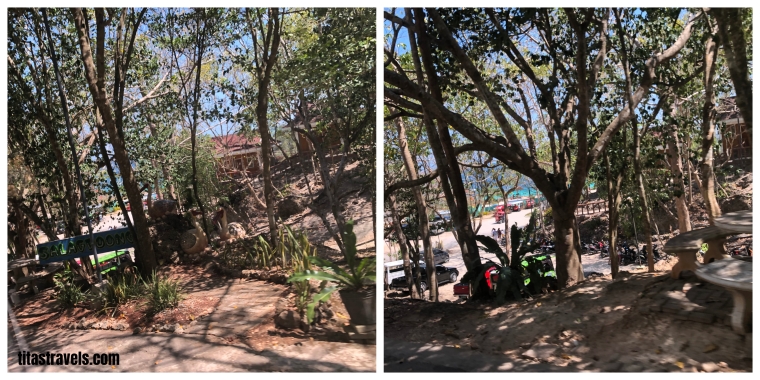 Entrance of Salagdoong Beach from access road
Entrance of Salagdoong Beach from access road
